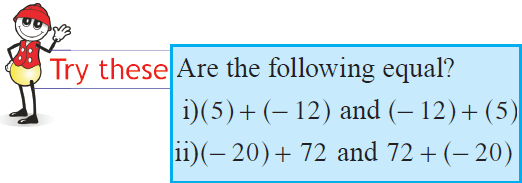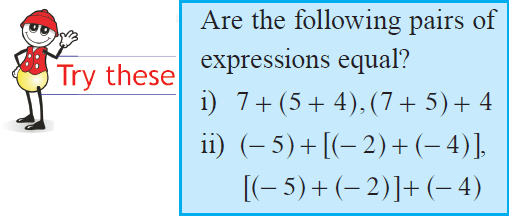PROPERTIES OF ADDITION
Subscribe to our ▶️ YouTube channel 🔴 for the latest videos, updates, and tips.
Following are the properties of addition :
(i) Commutative property
(ii) Associative property
(iii) Identity property
(iv) Property of additive inverse
(v) Distributive property
(vi) Property of equality
Commutative Property of Addition
Two real numbers can be added in any order.
In other words, addition is commutative for real numbers.
We have 8 + (- 3) = 5 and (- 3) + 8 = 5
So,
8 + (- 3) = (- 3) + 8
In general, for any two real numbers a and b we can say,
a + b = b + a
Therefore addition of real numbers is commutative.

Associative Property of Addition
Observe the following example :
Consider the real numbers 5, – 4 and 7.
Look at
5 + [(– 4) + 7] = 5 + 3 = 8
and
[5 + (– 4)] + 7 = 1 + 7 = 8
Therefore,
5 + [(– 4) + 7] = [5 + (– 4)] + 7
In general, for any real numbers a, b and c, we can say,
a + (b + c) = (a + b) + c.
Therefore addition of real numbers is associative.

Identity Property of Addition
When we add zero to any real number, we get the same real number.
Observe the examples :
5 + 0 = 5
0 + 7 = 7
-2 + 0 = -2
0 + (-3) = -3
In general, for any real number a,
a + 0 = a
0 + a = a
Therefore, zero is the additive identity for real numbers.

Property of Additive Inverse
The sum of a real number and its additive inverse is zero.
3 + (-3) = (-3) + 3 = 0
Note :
(i) If a number is positive, then its additive inverse is the same number with negative sign.
(ii) If a number is negative, then its additive inverse is the same number with positive sign.
Examples :
-5 is the additive inverse of 5
7 is the additive inverse of -7
Distributive Property of Multiplication over Addition
Consider the real numbers 12, 9, 7.
Look at
12 x (9 + 7) = 12 x 16 = 192
12 x (9 + 7) = 12 x 9 + 12 x 7 = 108 + 84 = 192
Thus
12 x (9 + 7) = (12 x 9) + (12 x 7)
In general, for any real numbers a, b, c.
a x (b + c) = (a x b) + (a x c)
Therefore, multiplication is distributive over addition.
Addition Property of Equality
Two sides of an equation remain equal, if the same number is added to each side.
For example, if x = y, then
x + z = y + z
Example :
3 = 3
Add 5 to each side.
3 + 5 = 3 + 5
8 = 8
Questions and Answers
Question 1 :
Given an example for commutative property of addition.
Answer :
3 + 5 = 5 + 3
Question 2 :
Given an example for associative property of addition.
Answer :
5 + (4 + 6) = (5 + 4) + 6
Question 3 :
Given an example for identity property of addition.
Answer :
7 + 0 = 0 + 7 = 0
Question 4 :
Given an example for property of additive inverse.
Answer :
7 + (-7) = (-7) + 7 = 0
Question 5 :
Find the addition of 0 and 5.87.
Answer :
According identity property of addition, the addition of 0 and any number is always equal to the number itself.
So,
0 + 5.87 = 5.87
Question 6 :
Find the addition of 3 and -3.
Answer :
3 and -3 are additive inverse to each other.
According to the property of additive inverse, the sum of a real number and its additive inverse is zero.
3 + (-3) = 0
Question 7 :
Evaluate the following multiplication using distributive property of multiplication over addition.
2(7 + 6)
Answer :
2(7 + 6) = 2 x 7 + 2 x 6
= 14 + 12
= 26
Question 8 :
Solve for x :
x - 3 = 0
Answer :
We can solve for x in the given equation, using addition property of equality. That is, two sides of an equation remain equal, if the same number is added to each side.
x - 3 = 0
Add 3 to both sides.
(x - 3) + 3 = 0 + 3
x - 3 + 3 = 3
x = 3
Question 9 :
Solve for x :
x - 7 = 9
Answer :
x - 7 = 9
Using addition property of equality, add 7 to both sides.
(x - 7) + 7 = 9 + 7
x - 7 + 7 = 16
x = 16
Question 10 :
15 is taken away from a number is equal to 8. Find the number.
Answer :
Let x be the number.
It is given that 15 is taken away from the number is equal to 8.
x - 15 = 8
Using addition property of equality, add 15 to both sides.
(x - 15) + 15 = 8 + 15
x - 15 + 15 = 23
x = 23
So, the number is 23.
Subscribe to our ▶️ YouTube channel 🔴 for the latest videos, updates, and tips.
Kindly mail your feedback to v4formath@gmail.com
We always appreciate your feedback.
About Us | Contact Us | Privacy Policy
©All rights reserved. onlinemath4all.com
Recent Articles
-
Specifying Units of Measure
Dec 15, 25 07:09 PM
Specifying Units of Measure -
Quantitative Reasoning Questions and Answers
Dec 14, 25 06:42 AM
Quantitative Reasoning Questions and Answers -
Coin Tossing Probability
Dec 13, 25 10:11 AM
Coin Tossing Probability - Concept - Sample Space - Formula - Solved Problems